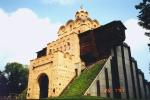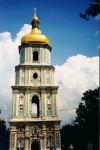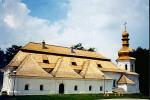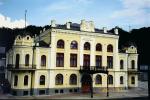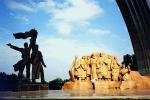SATURDAY JULY 26
I am awaken by barking dogs at 0730. I rummage around the luggage trying to sort out what I have, as stuff has been chucked in the bags since we left the village. By 0830, I have crashed around enough that Bill is awake. Olya fixes a good omelet with tomatoes, onions and peppers. She gives us directions on how to get to St Sophia Cathedral and background on a guy buried at the entrance. I only half understood what she said about the deceased and have already forgotten the other half. I try to phone KLM to confirm our return trip without success. For the first time I do some laundry and we are away by 1000.
We get off the metro at Zoloti Vorota and walk a short distance to the Golden Gate. It has been reconstructed to resemble the original 1037 main gateway to ancient Kyiv built by Yaroslov. Behind iron bars you can view two sections of the original fortification walls that surrounded the city. There is a rather nice bronze statue of Yaroslov the Wise on the grounds. He is the son of Prince Vladimir the Great, so in the 11th century he became the prince of the country. As I had climbed the stairs to the museum on the last trip, we did not do it again. We kind of follow the route Yaroslov would have walked to St. Sophia Cathedral. En route there are a number of decorative old buildings that are being gutted. The grandeur of these structures has long ago faded but the superb facades are being retained, reinforced with concrete and new rooms will be built in behind.
The St. Sofia Museum complex is as I remember. We enter through the four story Belltower. It looks like a blue and white tiered wedding cake with a gold bobble for adornment. The Sofiisky Sobor was built by Yaroslov in 1037. The chosen site was outside the city walls in an open field on which he had been victorious in battle. The design was based on St. Sofia in Turkey and Byzantium opulence still makes it a WOW place. Ancient mosaics and frescoes are abundant and many appear to be restored to their original vivid colours. The mosaic of Christ the Pantokrator and the Virgin Orans put one in a humble mode. Little is left of the fresco of Yaroslov and his family, so I have to strain to make out the faded figures. Remnants of the tile floor are under protective glass. I always feel eery when I am where ancients have tread. The iconostasis is outstanding with carved wooden columns that are covered in gold. I overhear that it is now only one third it's original height. In corridors off to the side, the paintings of angels are somewhat alternately repeated in similar dress and face. Yaroslov's intricately carved marble sarcophagus is indeed suitable for a man of his stature. I am so certain I had taken photos because the camera police were not interfering with tourists taking pictures as was the case last time. It appears that I only thought a lot about taking pictures or the damn camera was refusing to function as I have not one photo to substantiate the claims of the grandiose interior.
Not only did the Cathedral play a religious role, but it was the centre of social, political and cultural life, and it also housed the first library. It too was a casualty of numerous invasions. There is an added exhibition room that gives some history and info on archaeological digs, but we got little out of it as the descriptions were written in Ukrainian. The exterior of the cathedral has many bits of original brick left exposed when the building was restored. We spend a considerable amount of time prowling around the monastery grounds, but most buildings are closed. We are pretty well churched out so do not go into the Refrectory. As we leave, I recall taking a photograph as discretely as possible of a Balalaika player and again have no memento of the moment. Between the "Oh! No!, the picture did not turn out" (only to find out the roll has been completely developed with no sign of the missing picture) to the broken video camera, add to that my failing memory and soon I will be wondering if I ever visited Ukraine.
We cross the street to Sofiiska Ploshcha (St. Sofia Square) in order to have a closer look at the bronze statue of Bohdan Khmelnitsky. Attired in chieftain dress and seated astride a prancing horse, the stately statue towers above a huge granite pedestal. He was a popular 17th century Hetman who led the uprising to liberate Ukraine from Poland. Some folks consider this Cossack a traitor because in 1654 he was instrumental in the reunification of Ukraine with Russia.
We walk back down along the street with the pagan stuff seen on Podil day. A wedding party is laying flowers at the base of the statue of Olya in Mikhailivska Ploshcha, so we wonder if the brides name is Olya. Around the corner is the Church of St. John the Baptist. This church was the Refrectory of the St. Mikhail Monastery an apparently magnificent cathedral founded in 1108. A piece of vacant land is the only reminder that the monastery existed as it was destroyed by the Russians during their reign of terror on religion. It is extremely hot as we walk about the squeaky clean white church. It catches the eye because the roof is protected by sparkling wood shingles. Of particular interest is the cupola, also covered with shingles, but it is glittering like gold. Unfortunately, the church is closed. The grounds are fairly extensive in size but simply planted with grass. We follow a path from the church through Volodimirsky Park towards the funicular. The walk is relaxing as there are many interesting statues scattered among a vast rose garden. We wind around, heading down hill until we reach the monument of Prince Vladimir the Great, the Grand Prince of Rus during the 10th century. Probably because of the river, Kyiv was well established as a major town and trading centre long before Vladimir came to power, but it flourished under his reign. I do not know why he chose to embrace religion as apparently he was a pagan rouge, but the decision to convert to Christianity in 988 had a positive impact on Kyiv. Along with adopting Byzantium, he instituted political outlooks of the Greeks. The 20 metre bronze statue is erected near the spot that he baptised the ancient Ukrainians in the Dneipro River flowing below. He is dressed in the garb of an ancient warrior and is holding a large cross. We feel the light added to provide illumination of the cross is kind of tacky, brought on by visions of Darth Vader. From here the path brings us to the north end of the main thoroughfare, Kreshchatik Street. From a viewing platform we can see the Hall of Columns, now the Philharmonic building as well as the back side of the Ukrainsky Dim, now an exhibition hall. Also evident is from here is that Kreshchatic Street is situated in a deep valley. The name derives from the Ukrainian word for crossed as the hollow was once crossed by ravines.
We cross the Three Saints Street to the Church of St. Alexander. A wedding has just finished as we enter. The church is rather plain in decoration, but a couple of things stand out. There is a pictorial memorial board to a nun named Teresa. She was obviously revered. In a corner is a disturbing display on abortion. Here a young man is weeping, praying to the Saint. I can only speculate why. Into the Ukrainsky Dim we go, looking for a bathroom. The building is well maintained except for that area. There are some excellent woven tapestries covering the immense walls of the hall. They depict Ukrainian life as well as scenes of astronauts. Here I cash travellers cheques so with money and empty bladders, we take the underpass that goes beneath the busy circular intersection called Evropeyska Ploshcha. An outdoor cafe affords a good place to people watch, but also provides easy access to kids sent by waiting parents to beg for money. The charitable side of me has disappeared as I am sick of the beggars everywhere and I no longer say hello to people on the street as they inevitably hit me up for money.
We cross over again to explore around the Philharmonia, with it's cheerful facade. The best we could do was peer in the windows for a glimpse of the inside as yet again doors are locked. A short fight of steps brings us to the enormous metallic arch that Katya and I visited. It was built to commemorate the unification of Ukraine and Russia, but today it is only a reminder of Soviet domination. Something new has been added to the sculptures nearby - graffiti. Beyond this, is a viewing platform that provides yet another excellent view of the river and beaches far below and the concrete ghettoes of the east side. We also see the pedestrian bridge across the Dnieper and make a mental note to walk across tomorrow. Exploring further along Vulitsya Mikhaila Grushevskoho beyond a pretty purple library, we enter the Dynamo Stadium. The playing field is maintained, but other areas such as the Olympic size swimming pool have been abandoned and are in disrepair. We find the statue of the soccer players that were victorious in a match with the Germans and who paid dearly for the win. Subsequently the team was banished to a concentration camp where with the exception of one player, all were shot. Exiting, we prowl around the closed Museum of Ukrainian Art. The exterior is neat. The architecture appears to have Grecian influence including great columns and stone carvings below the roof. Two really neat ferocious stone lions guard the entrance.
We have come full circle to the large circular intersection. Here we admire a few old buildings constructed at the turn of the century. As Kyiv suffered severe bombing during WWII, most of the buildings lining Kreshchatik Street were built after the conclusion of the war. We encircle Maiden Nezalezhnosti, a popular square for Kyiviens to congregate. The square is quite large with many fountains. Under Soviet jurisdiction, it was named "October Revolution Square". Ukrainians are eliminating any reminders of Russian presence in Ukraine and so have been renaming streets and public buildings that reflect Russian influence. A gate through the defence wall to the city stood here during Yaroslov's reign. There are many vendors in the square as well as shops at the perimeter. We explore some of the side streets that provide mixed interest levels. At a nearby restaurant we enjoy our first good meal since L'viv. Sustenance restored, we enter one of the many underpasses in Kyiv to get to the Muscova Hotel. The hotel is built high on a hill. It is a good climb up the steps so we rest on the red granite platform on which a Lenin statue was once situated. Today, kids are skateboarding on it. The entrance to the hotel affords an excellent view of the square far below, but I am not impressed with the interior of the Moscova. Still on this hill, but across a street, we look around a very yellow Palace of Culture which once was a finishing school for girls. We take a route through a lovely wooded area and then return to the steps near the hotel. Below us is the Tchaikovsky State Conservatory where I took shelter from the rain during my last visit. Thinking it would be neat to see the fountains lit up at night, I decide we shall sit until dark, but boredom sets in, so we head for Olya's.
Olya's nephew Valery is visiting. They
were both born in Kyiv, but they speak mostly Russian. When I use my Ukrainian
dictionary to clarify words, interestingly both of them are unfamiliar
with many Ukrainian words contained in my Slovar. Intriguing too,
is that they are fluent in German. Over tea and cookies, we talk about
the war. Olya was a med student working at a clinic when at 0300
the bombs hit Kreshchatik. Even though "a noise" woke her up, she and the
staff could not understand why there were so many injured presenting to
the clinic. The patients had no idea what happened to them and it was not
until noon that day that it was announced on the radio that the city had
been shelled. The relentless bombing by the Nazis resulted in half of the
city being destroyed. Our hosts told of the devastation and showed us old
photographs of Kyiviens clearing the rubble from the streets. They said
that everyone in the community took part in the clean up. The occupation
of Kyiv lasted 800 days and 195,000 Kyiviens lost their lives.
I cut my shower short as the water is
spraying from the tap as if from a fountain.

All materials herein are copyrighted by the author. Permission must be granted by the author for any use of the material (text or images) contained in this diary. E-mail: theclarks@telus.net.
